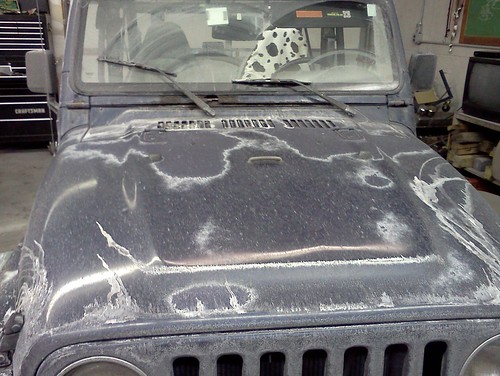It is an unpleasant side effect of winter that in order to keep traffic moving, those maintaining roadways must resort to some sort of salting practice. A bit of chemistry is in order here. When salt is mixed with snow and ice, i.e. water, it lowers the freezing point of that water. Therefore, it takes a colder surface and air temperature mix to refreeze this water making removal of the snow and ice from the roadway much easier. Regular table salt will deice a walkway but if the ground or air temperatures get to 15F, you can expect to see the ice refreeze.
People charged with getting roads clear and keeping roads clear use mixes of sodium chloride, what we call table salt, and magnesium chloride in order to lower the freezing point of water to where it evaporates on its own or can be cleared, in the case of slush or snow, from roadways.
We all know what this translates into on these days right after a snow, salt spray. Driving from Wheaton to Cedar Rapids, the effects of following trucks going 55+ is evident on my Jeep.
The spray pooled on the fender by the hood latch, streaked across the hood and splashed against the grill. I ran out of washer fluid on the way home. That's one of those things where you pull into a gas station to fill up and think, "Should I get another bottle?" You do, fill the reservoir and then discover you have 3 half-full bottles at home. I didn't get a new bottle when I stopped for gas. I have to find the half-filled bottle I have in the basement.
This much salt residue on my car yields more than just the unsavory bit it does to the paint and the metal. Try as I might to get into the car without bumping up against it, I fail and I have a streak down the pant leg of my black twill pants that is white with salt residue. I really need to wash off the car but if I do that, I run the risk of freezing the doors shut. Plus, my new top has salt spray on it.
I followed a county truck on I-380 through Cedar Rapids that was laying down the liquid mix instead of the pellets. Some places have gone to a sugar beet mixture for removing ice and snow. It's less harmful on the environment than rock salt and it does the same thing that salt does, lowers the freezing temperature of snow and ice which makes it easier to remove from roadways and to melt and evaporate. It does cost more than rock salt, unfortunately, which means the cost gets passed on to residents. And it still kicks up the spray although anecdotal stories say it's not as damaging to cars.
So, here I am with a dilemma. I was thinking of just tossing a half bucket of warm water on part of the car to get some of the salt off. I'd do half of the car on Saturday and the other half on Sunday. I could move the car so it would be in the sunshine to take advantage of melting and evaporation so the doors wouldn't freeze shut. I have errands to run this weekend which also helps in keeping the doors frost free. On the other hand, I could just wait until we get more snow and smush it around on the body to take off the top layer of salt. Don't tell me you haven't done that because I know you have. You've even used snow to wash off your front window when you're almost home and out of washer fluid.
In a way, it's kind of interesting, to see the patterns of salt on the Jeep and to see the complete color change to the body. But, I really should do something. Could I get a half inch of rain over here, please? Now that my top is secure, it won't rain.
Beverage: Dr Pepper
Deb


No comments:
Post a Comment